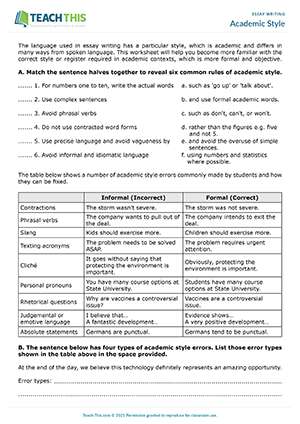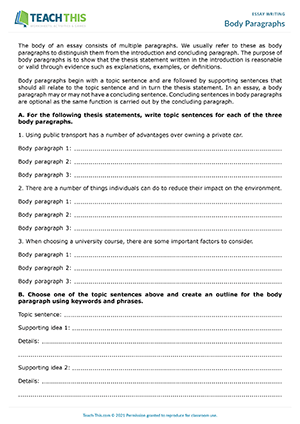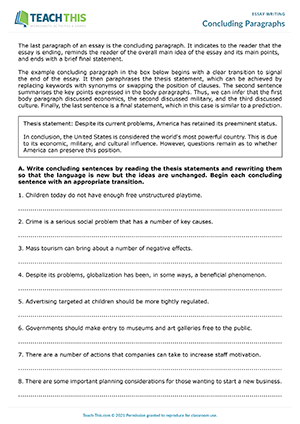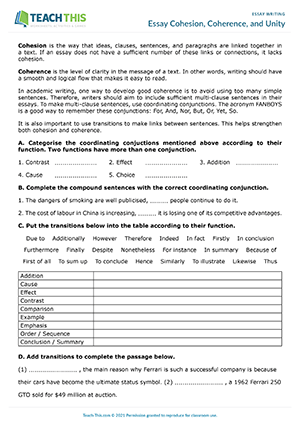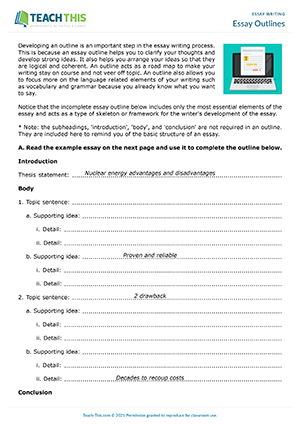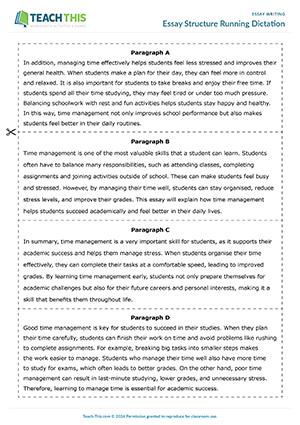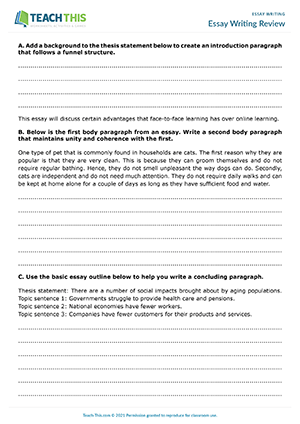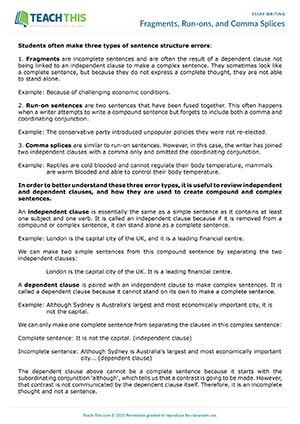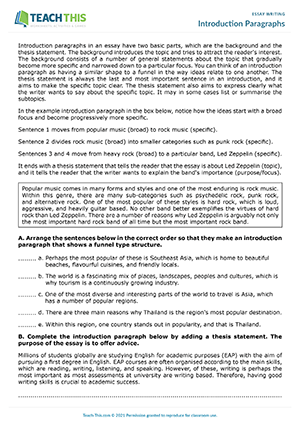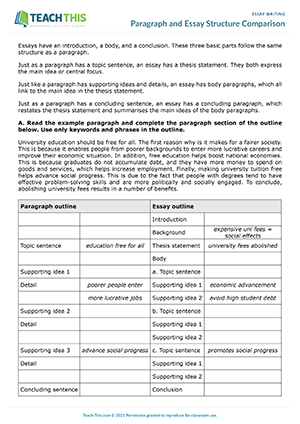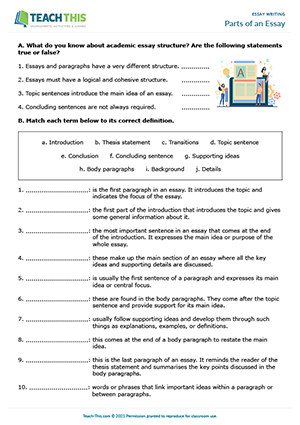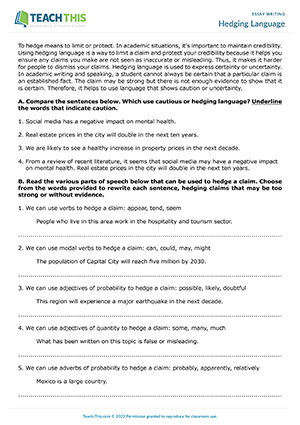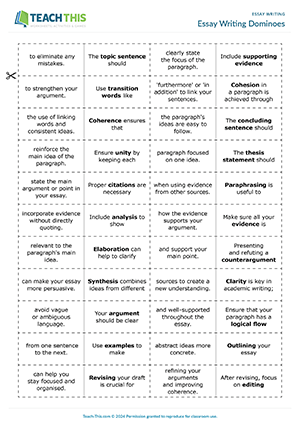In this free academic style worksheet, students learn and practice some common rules of academic style for essay writing. First, students match sentence halves together to reveal six common rules of academic style in essay writing. Next, students review a table that shows a number of academic style errors commonly made by students and how they can be fixed. Students then analyse an example sentence to identify and categorise the academic style errors. After that, students look at a table containing a number of informal words and phrases and replace them with appropriate formal words. Next, students read an essay to identify and underline academic style errors. Finally, students review the provided revised version of the essay that adheres to academic style rules.
In this informative body paragraphs worksheet, students practice planning and writing body paragraphs that support a thesis statement. To begin, students read an introductory text about body paragraphs. Students then write topic sentences for body paragraphs that support a thesis statement. Next, students choose one of the topic sentences and create an outline for the body paragraph using keywords and phrases. After that, students use the paragraph outline to write a complete body paragraph. Finally, students read the first body paragraph from an essay and then write a follow-up paragraph that supports an additional and related point on the topic.
In this useful concluding paragraphs worksheet, students learn and practice writing concluding paragraphs that restate a thesis statement, summarise key points and end with a final statement. First, students read a short text explaining the elements that make up a concluding paragraph and examine an example concluding paragraph and its structure. Students then write concluding sentences by reading thesis statements and rewriting them so that the language is new but the ideas are unchanged. Next, students use notes from basic essay outlines to write the first two sentences of three concluding paragraphs. The first sentence is a concluding sentence and the second sentence summarises the main ideas of the body paragraphs. Finally, students use essay questions to write their own concluding paragraphs that contain a concluding sentence beginning with a transition, a summary of the key points from the body paragraphs and a final statement.
In this comprehensive essay writing worksheet, students learn and practice essay cohesion, coherence and unity. Students start by reading information about cohesion, coherence, coordinating conjunctions and transitions. Students then categorise coordinating conjunctions according to their function. Next, students complete compound sentences with the correct coordinating conjunction. After that, students place transitions into a table according to their function. Students then move on to complete a short passage with suitable transitions. Afterwards, students read about how pronouns can be used to improve coherence in writing. Students then rewrite a paragraph by replacing nouns with pronouns from a table to improve the paragraph's overuse of key terms. Next, students read a brief explanation of 'unity' and then identify the sentence in a paragraph that is off-topic and breaks unity. In the final exercise, students review an essay to identify and underline errors with cohesion, coherence and unity.
This productive essay outlines worksheet helps to teach students how to create outlines as part of the essay writing process. To start, students read about the importance of an outline in the essay writing process. Students then read an example essay and use it to complete an essay outline. Next, students read and analyse an essay question and brainstorm ideas to include in an essay outline about the topic. After that, students create an outline for the essay based on their brainstormed ideas. In the last exercise, students write a complete essay based on the outline.
This essay writing running dictation activity helps students practice the key components of essay structure. First, one student in each pair stands up, runs to paragraph text A, B, C or D, reads a sentence or two, runs back and dictates what they read to their partner, who writes it down. Halfway through the two students swap roles. When the paragraph has been dictated, pairs compare their text with the original. Pairs then read about different parts of an essay and write short answers about which part of an essay their paragraph is from and the elements that make it so. After that, pairs expand on their answers by writing a complete explanation. Next, go through the four paragraphs that form an essay and the students' explanations by having pairs read their dictated paragraphs in order starting with the introduction. After each paragraph has been read out, pairs read their explanations. Finally, in groups, students discuss two questions about the structure of essays.
In this handy essay writing review worksheet, students revise basic academic essay writing and practice the skills covered in previous worksheets in this series. Students begin by adding a background to a thesis statement in order to create an introduction paragraph that follows a funnel structure. Next, students read the first body paragraph from an essay and write a second body paragraph that maintains unity and coherence with the first. Students then use a basic essay outline to help them write a concluding paragraph. After that, students identify academic style issues in a body paragraph and rewrite the paragraph so that it shows an appropriate register. Next, students rewrite sentences, so they are structurally and grammatically correct. Students then move on to read an essay that is missing cohesive devices such as transitions and sentence connectors. Students then match cohesive devices with the gaps to complete the essay. Students end by reviewing some basic knowledge about essay writing by answering true or false statements.
In this insightful sentence structure errors worksheet, students practice identifying and correcting fragments, run-on sentences, and comma splices. First, students read explanations of fragments, run-on sentences and comma splices. Students also review independent and dependent clauses, and how they are used to create compound and complex sentences to better understand the three error types. Students then read sentences and identify coordinating conjunctions, subordinating conjunctions, subjects and verbs. Next, students identify independent clauses and dependent clauses in sentences and classify them as either compound or complex. Lastly, students identify three sentences with errors and rewrite them so that they are correct, categorising the errors as either being a fragment, run-on sentence, or comma splice.
In this engaging introduction paragraphs worksheet, students learn and practice how to write introduction paragraphs that have a background and thesis statement and show a funnel type structure. First, students read a short passage, explaining the parts and structure of an introduction paragraph. Students also examine an example introduction paragraph and its organisation to reinforce introduction paragraph structure. Students then move on to reorder sentences so that they make a logical and coherent introduction paragraph that shows a funnel type structure. Next, students add a thesis statement to general statements in order to complete an introduction paragraph. Students then write a complete introduction paragraph by adding general statements to a thesis statement. After that, students use prompts to write an introduction paragraph that begins with general statements and ends with a thesis statement. In the final exercise, students are given freer practice to write an introduction paragraph on a specific topic without the guidance of prompts.
In this detailed paragraph and essay structure worksheet, students compare paragraph and essay structure to familiarise themselves with the basic parts of an academic essay. Students begin by reading about the similarities between paragraph structure and basic essay structure. Students then read an example paragraph and complete a paragraph outline to understand its structure. Next, students read an example essay and complete an essay outline to reinforce their understanding of essay structure. In the final exercise, students read the example essay one more time and answer questions about the essay's organisation.
In this free parts of an essay worksheet, students learn about the various parts that make up an academic essay and practice writing a structured, logical, and cohesive essay. Students start by answering three true or false statements to review some basic essay structure knowledge. Next, students unscramble letters to reveal the key terms used to describe the various parts of an academic essay and match them to their definitions. After that, students read an example essay to identify its key parts. In the last exercise, students create an essay outline on the topic of healthy eating and then use the outline to write a short essay that demonstrates all the parts of an academic essay.
In this useful hedging language worksheet, students learn and practice words and phrases that can be used in academic writing and speaking to soften a claim and maintain academic integrity. To start, students compare four sentences and identify those that use hedging language, underlining the words that express caution. Next, students read the various parts of speech that can be used to hedge a claim. Students then choose from the words provided to rewrite each sentence, hedging claims that may be too strong or without evidence. After that, students unscramble each 'that clause' and use two sentences provided to make a single sentence that contains a claim that is hedged. In the last exercise, students use 'adjective + to clauses' to hedge the claims made.
Here is a fun essay writing game to help students review and reinforce their understanding of key terms and concepts in essay writing. To begin, students turn over the top domino from the pile and place it face-up on the table. The first player then puts a domino down before or after the domino on the table, making sure that the two sentence halves match to form a sentence that expresses a key term or concept in essay writing. The other players then take turns matching their dominoes in the same way by putting them down at either end of the domino chain. If a player cannot put down one of their dominoes, they take one from the pile and put it down if they can. If there are no dominoes left in the pile, play passes to the next student. The first player to get rid of all their dominoes wins the game.
Latest Free
Resources
- The Bus Stop
Getting Around (B1)
Date Added: 1st of October
- Study Skills Showdown
Study Skills (B2)
Date Added: 10th of September
- Everyday Objects Bingo
Everyday Objects (A1-A2)
Date Added: 25th of August
- Action Verb Races
Actions (A1-A2)
Date Added: 18th of August
- Birthday Basics
Birthdays (A1-A2)
Date Added: 8th of August
Latest Member
Resources
- Casual Greetings
Greetings and Introductions (B2)
Date Added: 22nd of October
- Identifying and Clarifying Problems
Dealing with Problems (B2)
Date Added: 22nd of October
- What if we tried...?
Dealing with Problems (B2)
Date Added: 22nd of October
- Suitable Excuses
Making Excuses (B2)
Date Added: 21st of October
- Superlatives Showdown
Superlatives (A1-A2)
Date Added: 21st of October



